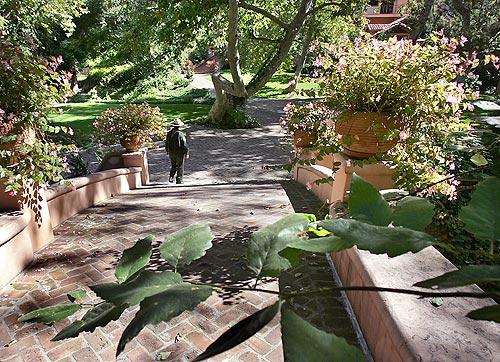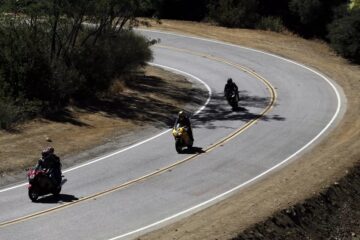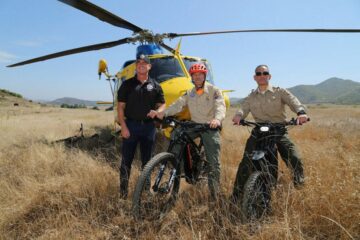Malibu roiled by plan for overnight camping, more trails
Some residents say they fear that natural areas will be despoiled. But backers of greater access say foes want to keep the beauty for themselves.
Source of this article – Los Angeles Times, December 23, 2006.
Martha Groves
Behind a gate at the end of a private Malibu road, nestled amid sycamore and coast live oak trees in a complex once owned by Barbra Streisand, sits the headquarters of the Santa Monica Mountains Conservancy.

THE GREAT OUTDOORS: Ramirez Canyon, above, is one of the locations where trails and campsites would be added under the Santa Monica Mountains Conservancy’s plan. (Brian van der Brug / LAT)
The site’s woodsy serenity belies a clash now echoing through the community.
To the consternation of city officials and canyon residents, the conservancy is proposing to allow overnight camping and create more public trails in some canyons and hillsides. Goals include completing a long-envisioned Coastal Slope Trail and providing more parking and greater access via public buses and shuttles.
This suggestion has sparked a dispute over access in a city famous for such battles.
Property owners say they are concerned about traffic, errant Carl’s Jr. wrappers and careless hikers or campers who might flick cigarettes into tinder-dry vegetation. Mostly unspoken is the suggestion that excluding the hoi polloi could also keep property values lofty.
“The general public doesn’t respect the land and take care of it,” said Marian Hall, a longtime Malibu resident and author of “Malibu: California’s Most Famous Seaside Community.” “Most of them come here and think somebody else will pick up their trash.”
Proponents of easier access, on the other hand, contend that some Malibu residents, in the guise of protecting nature and wildlife, are selfishly trying to keep away outsiders and the traffic, noise and intrusions they inevitably bring.
The debate has put many Malibu residents at odds with a man once considered a savior: Joseph T. Edmiston, the conservancy’s executive director.
Central in the dispute is the compound in narrow Ramirez Canyon where Edmiston often welcomes visitors at the agency’s offices. Streisand donated the 22.5-acre haven to the conservancy in 1993.
It is now a gated state park — one that relatively few people know about or visit. At the request of neighbors, the California Coastal Commission requires that the public use the property by appointment only.
The situation is ironic, indeed, for a state agency whose mission is to further the use of public lands.
Land disputes have long plagued Malibu, going back more than 100 years to Frederick Hastings Rindge, who once owned the entire place.
Rindge searched for years for a coastal haven in California that rivaled the spectacular rivieras of Monte Carlo and Italy’s Amalfi coast. He found it in 1892, when he bought the 13,000-acre Rancho Topanga Malibu Sequit.
“Here in these almost hallowed hills, in this calm and sweet retreat, protected from the wearing haste of city life, an ennobling stillness makes the mind ascend to heaven,” the businessman wrote in his 1898 book, “Happy Days in Southern California.”

SYLVAN: Rorie Skei, a Santa Monica Mountains Conservancy official, strolls in Ramirez Canyon, where the agency is headquartered in a complex donated by Barbra Streisand. Special events there, to help defray maintenance costs, were suspended after neighbors sued. (Ken Hively / LAT)
Once Rindge had secured his paradise, he erected gates and posted “No Trespassing” signs. After he died, his widow, May Knight Rindge, exhausted her fortune fending off the mighty Southern Pacific railroad and engineers who wanted to build a railroad and a highway across her property.
Many of Malibu’s nearly 13,000 residents feel just as possessive and protective of their bucolic haven. Living in Malibu involves trade-offs. Summertime beach traffic holds locals hostage. Come fall, Santa Ana winds and arid hillsides produce occasional conflagrations. Winter brings rain, mudslides and lane closures on Pacific Coast Highway. Spring is cleanup time.
In return, residents can lope on horseback through rustic canyons, rest their eyes on ocean sunsets and trudge through chaparral and coastal sage scrub on the hillsides.
“You start with the dynamic that the city of Malibu exists because of a coalition of environmentalists and NIMBYs and people who just didn’t want to pay to have a sewer,” said Mary Nichols, director of the UCLA Institute of the Environment and former state secretary of natural resources.
Indeed, fearful of dense development, residents voted to incorporate in 1991 to stop construction of a sewer line promoted by pro-developer Los Angeles County supervisors. Over the years, residents have also successfully fought plans to build a nuclear reactor and a freeway.
“I think, historically, the community has been hostile to public access,” said Peter M. Douglas, executive director of the Coastal Commission. “It really has always smacked of exclusivity.”
Since its creation in 1980 by state lawmakers, the conservancy has spent $450 million to help preserve more than 60,000 acres of state parkland. Bearded and brash, Edmiston has been its only executive director. He has often tussled with locals.
Nowhere is that more evident than in Ramirez Canyon.
When Streisand donated the land, she pictured it as the home of an environmental think tank. That plan didn’t work out. In the mid-1990s, to help defray maintenance costs, the conservancy began renting out the site for weddings, movie shoots and private parties.
Neighbors resented the busloads of guests and catering vans that rumbled down the narrow 0.8-mile canyon road to its dead end. They sued to stop the extracurricular activities. They prevailed, and the conservancy recently suspended the events.
The conservancy’s new plan would allow it to resume holding dozens of special events, bus tours and outreach programs.
“The irony is that Joe Edmiston’s plan would bring in a lot more traffic and build a lot of trails and create the kind of use that would disrupt one of the pristine ecosystems,” said Veronique de Turenne, a freelance writer who lives near Ramirez Canyon, where she has seen coyotes, badgers, foxes, California quail, bobcats and roadrunners.
The conservancy has posted the latest version of its public access plan on its website: smmc.ca.gov. The Coastal Slope Trail would thread its way from the Zuma and Trancas canyons area on the west through Ramirez, Escondido, Solstice and Corral canyons. It would complement the Backbone Trail, which runs farther inland, from Point Mugu State Park to Will Rogers State Historic Park.
A chief goal, Edmiston said, is to provide 30 spaces for overnight camping, including for disabled individuals, in Ramirez, Escondido and Corral canyons. Visitors coming from the San Fernando Valley over Malibu Canyon Road are now greeted by a sign that proclaims “Overnight camping prohibited in the city of Malibu.”
Canyon camping would be supervised and would be prohibited on “red flag” days to reduce the chance of fire, many residents’ biggest concern. Camping areas would also have ready access to water in case of fire, the plan says.
Plans for an 18,000-square-foot parking lot for about 30 vehicles in Escondido Canyon have riled residents. Now, hikers must park in a lot on Winding Way at Pacific Coast Highway and walk about a mile to the trailhead.
The conservancy intends to present its plan directly to the Coastal Commission. That has outraged Malibu officials, who say the agency is trying to circumvent local land use laws and avoid preparing an environmental report.
After both sides threatened recently to sue each other once again, the conservancy and the city began talking, and Malibu Mayor Ken Kearsley is optimistic that the parties will be able to reach an agreement that “is a win for everybody.”
“We agree on everything,” Kearsley said. “Malibu needs camping, Malibu needs trails, Malibu needs more public access.”
As Malibu juggles development rights, privacy concerns and public needs, the dispute reminds longtime residents of the Rindges’ efforts to keep their rancho to themselves.
Like Frederick Rindge, Hall said, Malibu residents prize the mountains, canyons and beaches and are willing to fight to keep them as pristine as possible.
“They all live here just for the beauty and the landscape,” she said. “Commercializing on these canyons would be just a crime.”



0 Comments